 |
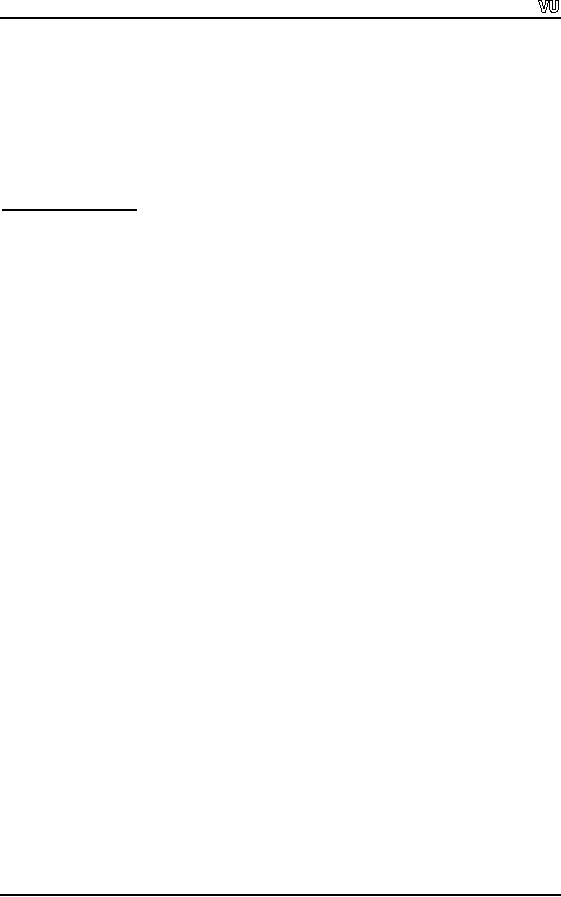
CS201
Introduction to Programming
Lecture
Handout
Introduction
to Programming
Lecture
No. 8
Reading
Material
Deitel
& Deitel C++ How to
Program
Chapter
2
2.16,
2.18
Summary
Switch
Statement
o
Break
Statement
o
Continue
Statement
o
Guide
Lines
o
Rules
for structured Programming/Flow
Charting
o
Sample
Program
o
Tips
o
Switch
Statement
Sometimes, we
have multiple conditions and
take some action according to
each
condition.
For example, in the payroll of a company,
there are many conditions to
deduct
tax
from the salary of an
employee. If the salary is
less than Rs. 10000,
there is no
deduction.
But if it falls in the slab
Rs. 10000 - 20000, then
the income tax is deducted.
If
it
exceeds the limit of Rs.
20000, some additional tax
will be deducted. So the
appropriate
deduction
is made according to the
category or slab of the
salary.
We can
also understand this from
the example of grades secured by
the students of a
class.
Suppose we want to print description of
the grade of a student. If
the student has
grade `A'
we print `Excellent' and
'Very good', 'good', 'poor'
and 'fail' for grades B, C,
D,
and F
respectively. Now we have to see
how this multi-condition situation
can be applied
in a
program. We have a tool for
decision making i.e. 'if
statement'. We can
use 'if
statement'
to
decide what description for a
grade should be displayed. So we check
the
grade in
if
statement and
display the appropriate description. We
have five categories
of
grades--
A, B, C, D, and F. We have to write
five if
statements to check
all the five
possibilities
(probabilities) of grade. So we write
this in our program as
under-
Page
67

CS201
Introduction to Programming
if (
grade == `A' )
cout
<< "Excellent" ;
if (
grade == `B' )
cout
<< "Very Good" ;
if (
grade == `C' )
cout
<< "Good" ;
if (
grade == `D' )
cout
<< "Poor" ;
if (
grade == `F' )
cout
<< "Fail" ;
These
statements are correct and
perform the required task.
But the 'if
statement' is
computationally
one of the most expensive
statements in a program. We call it
expensive
due to
the fact that the processor
has to go through many cycles to execute
an if
statement
to
evaluate a single decision. So to make a program more
efficient, try to use
the
minimum
number of if
statements. This
will make the performance of
the program better.
So if we
have different conditions in which
only one will be true as
seen in the example
of
student's grades, the use of
if
statement is very
expensive. To avoid this
expensiveness,
an alternate of multiple if
statements can be
used that is if/else
statements.
We can
write an if
statement in the
body of an if
statement which is known as
nested
if.
We can
write the previous code of
if
statements in the
following nested
if/else form.
If (
grade == `A' )
cout
<< "Excellent" ;
else if (
grade == `B' )
cout
<< "Very Good" ;
else if (
grade == `C' )
cout
<< "Good" ;
else if (
grade == `D' )
cout
<< "Poor" ;
else if (
grade == `F' )
cout
<< "Fail" ;
In the
code, there is single statement
with each if
statement. If
there are more
statements
with an
if
statement, then
don't forget the use of
braces and make sure
that they match
(i.e.
there is a corresponding closing
brace for an opening brace).
Proper indentation of
the
blocks should also be
made.
In the
above example, we see that
there are two approaches
for a multi way decision.
In
the
first approach, we use as many
if
statements as
needed. This is an
expensive
approach.
The second is the use of
nested if
statements. The
second is little more
efficient
than
the first one. In the
'nested
if statements' the
nested else is not executed
if the first if
condition
is true and the control
goes out of the if
block.
The C
language provides us a stand-alone
construct to handle these
instances. This
construct
is switch
structure. The
switch
structure is a
multiple-selection construct that
is
used in
such cases (multi way
decisions) to make the code
more efficient and easy to
read
and
understand.
Page
68

CS201
Introduction to Programming
The
syntax of switch statement is as
follows.
switch (
variable/expression
)
{
case
constant1
: statementLlist1 ;
case
constant2
: statementLlist2 ;
:
:
case
constantN
: statementListN ;
default :
statementList
;
}
In the
switch
statement,
there should be an integer variable
(also include char) or
an
expression
which must evaluate an integer type
(whole numbers only, the
decimal
numbers
2.5, 14.3 etc are
not allowed). We can't use
compound conditions (i.e. the
conditions
that use logical operators
&& or ||) in switch
statement
and in case
statements.
The
constants
also must
be integer constants (which
include char). We
can't use a
variable
name with the case
key word. The default
statement
is optional. If there is no
case
which
matches the value of the
switch
statement,
then the statements of default
are
executed.
The
switch
statement
takes the value of the
variable,
if there is
an expression
then
it
evaluates
the expression
and
after that looks for
its value among the
case
constants. If
the
value is
found among the constants
listed in
cases, the
statements in that statementList
are
executed. Otherwise, it does nothing.
However if there is a default (which
is
optional),
the statements of default
are
executed.
Thus
our previous grade example will be
written in switch statement as
below.
switch (
grade )
{
case `A'
: cout << "Excellent" ;
case
`B' : cout << "Very
Good" ;
case
`C' : cout << "Good"
;
case
`D' : cout << "Poor"
;
case
`F' : cout << "Fail" ;
}
We know
that C language is 'case
sensitive'. In this language, `A' is
different from `a'.
Every
character has a numeric value
which is stored by the
computer.. The numeric
value
of a
character is known as ASCII
code of the character. The
ASCII code of small
letters
(a, b, c
etc ) are different from
ASCII code of capital letters
(A, B, C etc). We can
use
characters
in switch statement as the
characters are represented as
whole numbers inside
the
computers.
Now we
will see how the
use of ' the letter a' instead of
'A' can affect our program.
We
want
our program to be user- friendly. We
don't want to restrict the
user to enter the
grade in
capital letters only. So we have to
handle both small and
capital letters in our
Page
69

CS201
Introduction to Programming
program.
Here comes the limitations of
switch
statement.
We can't say in our
statement
like
case `A'
or `a' : statements ;
We have
to make two separate cases
so we write
case
`A" :
case
`a' :
statements;
In the
switch
statement,
the cases fall through
the case
which is
true. All the
statements
after
that case
will be
executed right down to the
end of the switch
statement.
This is very
important
to understand it. Let's
suppose that the user
enters grade `B'. Now
the case `A'
is
skipped. Next case `B'
matches and statement cout
<< "Very Good" ; is
executed.
After
that, all the statements
will be executed. So cout
<< "Good" ; cout
<< "Poor"
;and
cout
<< "Fail" ; will be
executed after one another.
We don't want this to
happen.
We want
that when a case matches,
then after executing its
statement, the control
should
jump out
of the switch
statement
leaving the other cases. For
this purpose we use a
key
word
break.
Break
Statement
The
break
statement
interrupts the flow of control. We have
seen in switch
statement
that
when a
true case is found, the flow
of control goes through
every statement down
ward.
We want
that only the statements of
true case should be executed
and the remaining
should be
skipped. For this purpose,
we use the break
statement.
We write the break
statement
after the statements of a
case. Thus, when a true
case is found and its
statements
are executed then the
break statement interrupts the
flow of control and
the
control
jumps out of the switch
statement.
If we want to do the same
task for two
cases,
like in
previous example for `A' and
`a', then we don't put
break
statement
after the first
case. We
write both the cases (or
the cases may be more than
two) line by line then
write
the
common statements to be executed
for these cases. We write
the break
statement
after
these
common statements. We should
use the break
statement
necessarily after the
statements
of each case. The break
statement is necessary in switch
structure,
without it
the
switch
structure
becomes illogic. As without it
all the statement will
execute after first
match
case is found.
The
above code does nothing if
the grade is other than
these five categories (i.e. A, B,
C,
D and
F). To handle all the
possibilities of grade input, we
write a default statement
after
the
last case. The statement in
this default case is executed if no
case matches the
grade.
So in our
program, we can write the default
statement
after the last case as
under.
default :
cout << "Please enter
grade from A to D or F " ;
The
break statement is also used
in decision structures other than
switch structure. We
have
seen that in while,
do-while and
for
loops, we
have to violate some
condition
explicitly
to terminate the loop before
its complete repetitions. As in a program
of
guessing
a character, we make a variable tryNum
greater
than 5 to violate the while
Page
70
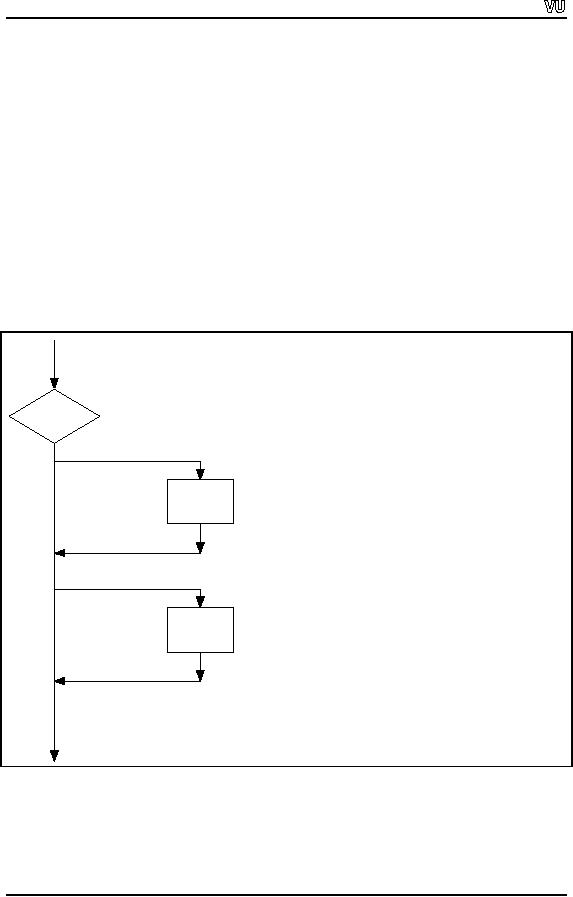
CS201
Introduction to Programming
condition
and exit the loop if
the correct character is
guessed before five tries. In
these
loops, we
can use the break
statement
to exit a loop. When a break
statement
is
encountered
in a loop, the loop terminates
immediately. The control
exits the inner most
loop if
there are nested loops.
The control passes to the
statement after the loop. In
the
guessing
character example, we want that if
the character is guessed in
first or second
attempt,.
then we print the message
`Congratulations, You guess is correct'
and exit the
loop. We
can do this by using a break
statement
with an if
statement.
If the character is
guessed,
we print the message.
Afterwards, the break
statement
is executed and the
loop
terminates.
So we can write this as
follows.
if ( c ==
`z' ) // c is input from
user
{
cout
<< "Great, Your guess is correct"
;
break;
}
Thus,
break
statement
can be used to jump out of a
loop very quickly.
The
flow chart of the switch
statement
is similar to if
statement
and is given below.
The flow
chart of switch statement
The number of
case statement can vary
from
1 to any
number. Thus there are
same
switch
number of
process blocks as
cases.
(variable
)
case
const
1
Process
break
case
const2
Process
break
Now we
can write the complete code
for the program that prints
the description of the
grade
entered by the user.
The
flow chart of the program is
given below.
Page
71
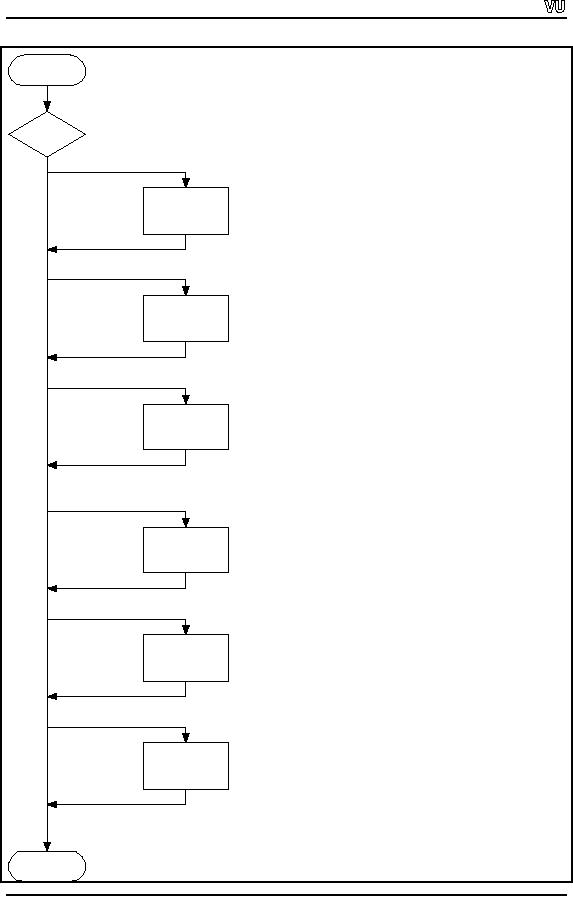
CS201
Introduction to Programming
The
flow chart of a program that displays the
description of a grade
using switch
statement
Start
switch
(grade)
case
'A'
Display
"Excellent"
break
case
'B'
Display
"Very
Good"
break
case
'C'
Display
"Good"
break
case
'D'
Display
"Poor"
break
case
'F'
Display
"Fail"
break
default
Display "
Please
enter
grade A-D or
F"
break
Stop
Page
72
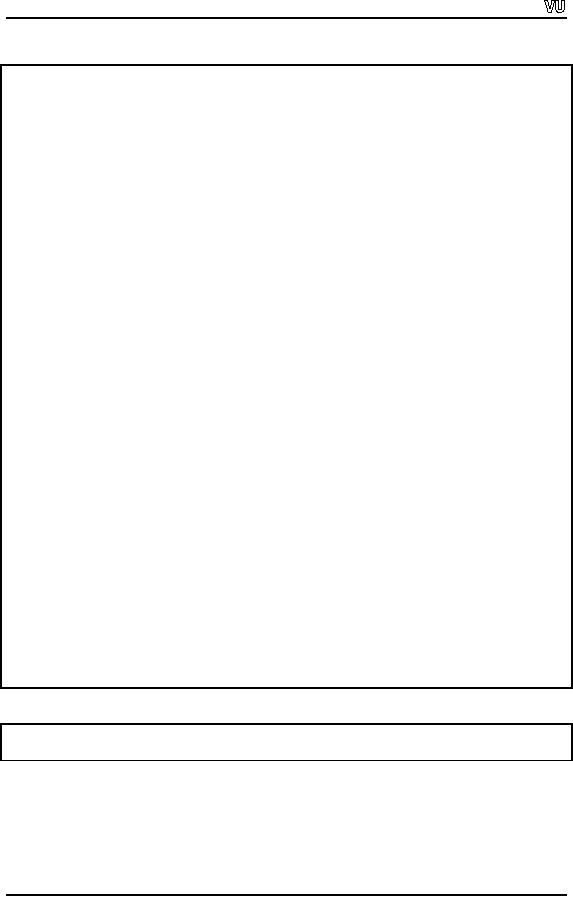
CS201
Introduction to Programming
The
code of the program is given
below.
//This
program gets a grade from
user and displays a description
accordingly
# include
<iostream.h>
main (
)
{
char
grade ;
cout
<< "Please enter the
student's grade : " ;
cin
>> grade ;
switch (
grade )
{
case `A'
:
// grade
was upper case A
case
`a' :
// grade
was lower case a
cout
<< "Excellent" ;
break
:
//
necessary to exit
switch
case
`B' :
// grade
was upper case B
case
`b' :
// grade
was lower case b
cout
<< "Very Good" ;
break :
// necessary to exit
switch
case
`C' :
// grade
was upper case C
case
`c' :
// grade
was lower case c
cout
<< "Good" ;
break :
// necessary to exit
switch
case
`D' :
// grade
was upper case D
case
`d' :
// grade
was lower case d
cout
<< "Poor" ;
break :
// necessary to exit
switch
case
`F' :
// grade
was upper case F
case
`f' :
// grade
was lower case f
cout
<< "Fail" ;
break :
// necessary to exit
switch
default
:
cout
<< "Please enter grade
from A to D or F " ;
}
}
A sample
out put of the program is
shown here.
Please
enter the student's grade :
b
Very
Good
continue
Statement
There is
another statement relating to loops.
This is the continue
statement.
Sometimes
we have a
lot of code in the body of a loop.
The early part of this code
is common that is
Page
73

CS201
Introduction to Programming
to be
executed every time (i.e. in
every iteration of loop) and
the remaining portion is to
be
executed in certain cases
and may not be executed in
other cases. But the
loop should
be
continuous. For this
purpose, we use the continue
statement.
Like the break
statement,
the
continue
statement
is written in a single line. We write it
as
continue
;
The
continue
forces
the immediate next iteration of
the loop. So the statements of
the
loop body
after continue
are
not executed. The loop
starts from the next
iteration when a
continue
statement
is encountered in the body of a loop. One
can witness very
subtle
things
while using continue.
Consider
the while
loop.
In while
loop,
we change the value of the
variable of while
condition
so that it could make the
condition false to exit the
loop. Otherwise, the loop
will
become an infinite one. We
should be very careful about
the logic of the
program
while
using continue
in a
loop. Before the continue
statement,
it is necessary to change
(increment/decrement)
the value of the variable on which
the while
condition
depends.
Similarly
it is same with the do-while
loop. Be careful to increment or decrement
the
conditional
variable before the continue
statement.
In for
loop,
there is a difference. In a while
loop
when continue
is
encountered, the
control
goes to the while
statement
and the condition is
checked. If condition is true
the
loop is
executed again else the
loop exits. In a for
loop,
the three things i.e.
initialization,
condition
and increment/decrement are
enclosed together as we write
for
( counter = 0 ;
counter
<= 5 ; counter ++) . In the
for
loop
when a continue
is
encountered, the
counter
(i.e.
loop variable) is incremented at first
before the execution of the
loop condition.
Thus, in
'for
loop'
the increment to the loop variable is
built in and after continue
the
next
iteration of
the loop is executed by incrementing
the loop variable. The
condition is
checked
with the incremented value
of the loop variable. In while
and
do-while
loop,
it is
our
responsibility to increment the value of
the loop variable to test
the condition. In a for
loop, the
continue
automatically
forces this increment of value
before going to check
the
condition.
goto
Statement
Up to now
we have covered the basic
programming constructs. These include
sequences,
decisions
and repetition structures (i.e. loops). In
sequences, we use the simple
statements
in a
sequence i.e. one after the
other. In decisions construct we
use the if
statement, if/else
statement, the
multi way decision construct (i.e.
the switch
statement). And in
repetition
structures,
we use the while,
do-while and
for
loops.
Sometime
ago, two computer scientists Gome
and Jacopi proved that any
program can be
written
with the help of these
three constructs (i.e. sequences,
decisions and loops).
There is
a statement in the computer languages
COBOL, FORTRON and C.
This
statement
is goto
statement.
The goto
is an
unconditional branch of execution. The goto
statement
is used to jump the control
anywhere (back and forth) in
a program. In legacy
programming,
the programs written in
COBOL and FORTRAN languages
have many
unconditional
branches of execution. To understand and
decode such programs
that
contain unconditional
branches is almost impossible. In such
programs, it is very
Page
74

CS201
Introduction to Programming
difficult,
for a programmer, to keep the track of
execution as the control jumps
from one
place to
the other and from
there to anywhere else. We
call this kind of
traditional code as
spagatti
code. It is very difficult to
trace out the way of
execution and figure out
what the
program
is doing. And debugging and
modifying such programs is
very difficult.
When
structured programming was started, it
was urged not to use the goto
statement.
Though
goto
is
there in C language but we
will not use it in our
programs. We will
adopt
the
structured approach. All of our
programs will consist of
sequences, decisions
and
loops.
Guide
Lines
In
general, we should minimize
the use of break statement
in loops. The switch
statement
is an exception in
this regard where it is necessary to
use the break
statement
after every
case.
Otherwise, there may be a logical
error. While writing loops,
we should try to
execute
the loops with the
condition test and should
try to avoid the break
statement.
The
same
applies to the continue
statement.
The continue
statement
executes some
statements
of the
loop and then exits
the loop without executing
some statements after it. We
can use
the
if
statement
for this purpose instead of
continue. So
never use the goto
statement
and
minimize
the usage of break
and
continue
statements
in loops. This will make
the code
easy to
understand for you and
for others. Moreover the
additions and modifications to
such
code will be easy, as the
path of execution will be easy to
trace.
Make a
program modular. This means that
divide a large program into
small parts. It will
be easy
to manage these small parts
rather than a larger program.
There should be single
entry and
single exit in every module or construct.
The use of break
statement
in a
construct
violates this rule as a loop having a break
statement
can exit through break
statement
or can terminate when the
loop condition violates. As there
are two exit points,
this
should be avoided. The single entry-
single exit approach makes
the execution flow
simple.
Here is an example
from daily life, which shows
that single entry and single exit
makes
things
easy. You would have often
seen at a bus stop, especially in
rush hours, that
when
a bus
reaches the stop, everyone
tries to jump into the bus
without caring for others.
The
passengers
inside the bus try to get
down from the vehicle. So
you see there a
wrestling
like
situation at the door of the
bus. Separate doors for
entering or exiting the bus
can be
the
solution. In this way, the
passengers will easily enter or
exit the bus.
We have
applied this single entry and single exit
rule in drawing our flow
charts. In the
flow
charts, we draw a vertical
line from top to down.
The point where the line
starts is
our entry
point and downward at the
same line at the end is
our exit point. Our all
other
processes
and loops are along or
within these two points.
Thus our flow charts
resemble
with
the code.
Page
75

CS201
Introduction to Programming
Rules
for Structured Programming/Flow
Charting
There
are few simple rules
for drawing structured flow
charts of programs. One
should be
familiar
with these.
Rule
No:1-Start
with the simple flow
chart. This means that
draw a start symbol, draw
a
rectangle
and write in it whatsoever
you want to do and then
draw a stop symbol. This
is
the
simplest flow chart.
Rule
No:2- Any
rectangle ( a rectangle represents a
process which could be input,
output
or any
other process) can be
replaced by two
rectangles.
This
concept is the same as
taking a complex problem and
splitting it up into two
simpler
problems. So we
have `split it up' method to
move towards a modular approach. So
start
with a
block (rectangle) and then
any rectangle can be
replaced by two
rectangles
(blocks).
Rule
No:3- Any
rectangle can be replaced
with a structured flow charting
construct.
These
construct include decisions, loops or
multi- way decision. This
means that we can
put a
structure of an if
construct
or switch
construct
in the place of a rectangle. Here
we
come to
know the advantage of single entry
and single exit concept.
This single entry and
single
exit block can be replaced
with a rectangle.
Rule
No: 4- This rule
states that rule number 2
and 3 can be repeated as
many times as
you
want.
By using
these rules we are splitting
a problem into simpler units so
that each part can
be
handled
either by sequences (one
rectangle, second rectangle
and so on) or by a decision
(if,
if/else, switch or by a loop). Through
this approach, a large
problem can be solved
easily.
The
flow charts drawn with
these rules and indented to
the left side will
have one to one
correspondence
with our code. Thus it
becomes very easy to
identify the code that
is
written
for a specific part of the
flow chart. In this way
the code can easily be
debugged.
Sample
Program
Let's
consider a problem. In a company, there
are deductions from the
salary of the
employees
for a fund. The deductions
rules are as follows:
i)
If salary
is less than 10,000 then no
deduction
ii)
If salary
is more than 10,000 and less
than 20,000 then deduct
Rs. 1,000 as
fund
iii)
If salary
is equal to or more than
20,000 then deduct 7 % of
the salary for
fund
Take
salary input from user
and after appropriate
deduction show the net
payable amount.
Solution
As we see
that there is multi way
decision in this problem, so we use switch
statement.
The
salary is the switch variable
upon which the different
decisions depend. We can
use
only a
single constant in case
statement.
So we divide the salary by
10000 to convert it
Page
76
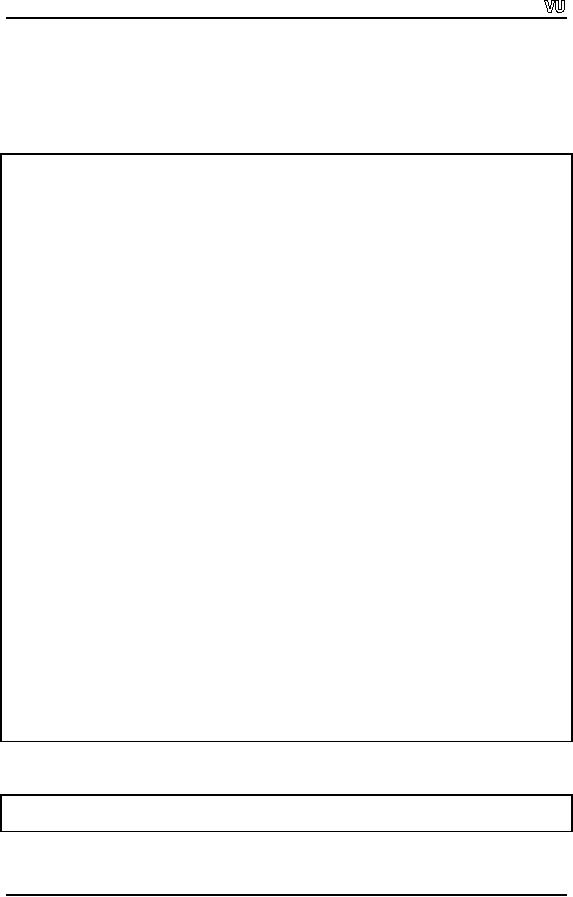
CS201
Introduction to Programming
into a
single case constant. As we know
that in integer division we
get the whole
number
as the
answer. Thus if answer is 0
the salary is less than
10000, if answer is 1 then it is
in
range
10000 to 19999 ( as any
amount between 10000
19999 divided by 10000
will
result
1). If the answer is greater
than 1, it means the salary
is equal to or more than
20000.
Following
is the complete code of our
program.
// This
program gets salary input
from user and calculates
and displays the net
payable
// amount
after deduction according
the conditions
# include
<iostream.h>
main (
)
{
int
salary ;
float
deduction, netPayable ;
cout
<< "Please enter the
salary : " ;
cin
>> salary ;
// here
begins the switch
statement
switch (
salary / 10000 ) // this
will produce a single
value
{
case 0
:
// this
means salary is less than
10,000
deduction
= 0; // as deduction is zero in this
case
netPayable
= salary ;
cout
<< "Net Payable (salary
deduction) = " ;
cout
<< salary << " - " << deduction
<< " = " << netPayable;
break;
//necessary
to exit switch
case 1
:
// this
means salary is in range
10,000 19,999
deduction
= 1000 ;
netPayable
= salary deduction ;
cout
<< "Net Payable (salary
deduction) = " ;
cout
<< salary << " - " << deduction
<< " = " << netPayable;
break;
//necessary
to exit switch
default
:
// this
means the salary is 20,000
or more
deduction
= salary * 7 /100 ;
netPayable
= salary deduction ;
cout
<< "Net Payable (salary
deduction) = " ;
cout
<< salary << " - " << deduction
<< " = " << netPayable;
}
}
Here is
the out put of the
program.
Please
enter the salary :
15000
Net
Payable (salary deduction) =
15000 1000 =
14000
Page
77

CS201
Introduction to Programming
Tips
�
Try to
use the switch
statement
instead of multiple if
statements
�
Missing a
break
statement
in a switch
statement
may cause a logical
error
�
Always
provide a default
case in
switch statements
�
Never
use goto
statement
in your programs
�
Minimize
the use of break
and
continue
statements
Page
78
Table of Contents:
- What is programming
- System Software, Application Software, C language
- C language: Variables, Data Types, Arithmetic Operators, Precedence of Operators
- C++: Examples of Expressions, Use of Operators
- Flow Charting, if/else structure, Logical Operators
- Repetition Structure (Loop), Overflow Condition, Infinite Loop, Properties of While loop, Flow Chart
- Do-While Statement, for Statement, Increment/decrement Operators
- Switch Statement, Break Statement, Continue Statement, Rules for structured Programming/Flow Charting
- Functions in C: Structure of a Function, Declaration and Definition of a Function
- Header Files, Scope of Identifiers, Functions, Call by Value, Call by Reference
- Arrays: Initialization of Arrays, Copying Arrays, Linear Search
- Character Arrays: Arrays Comparisonm, Sorting Arrays Searching arrays, Functions arrays, Multidimensional Arrays
- Array Manipulation, Real World Problem and Design Recipe
- Pointers: Declaration of Pointers, Bubble Sort Example, Pointers and Call By Reference
- Introduction, Relationship between Pointers and Arrays, Pointer Expressions and Arithmetic, Pointers Comparison, Pointer, String and Arrays
- Multi-dimensional Arrays, Pointers to Pointers, Command-line Arguments
- String Handling, String Manipulation Functions, Character Handling Functions, String Conversion Functions
- Files: Text File Handling, Output File Handling
- Sequential Access Files, Random Access Files, Setting the Position in a File, seekg() and tellg() Functions
- Structures, Declaration of a Structure, Initializing Structures, Functions and structures, Arrays of structures, sizeof operator
- Bit Manipulation Operators, AND Operator, OR Operator, Exclusive OR Operator, NOT Operator Bit Flags Masking Unsigned Integers
- Bitwise Manipulation and Assignment Operator, Programming Constructs
- Pre-processor, include directive, define directive, Other Preprocessor Directives, Macros
- Dynamic Memory Allocation, calloc, malloc, realloc Function, Dangling Pointers
- History of C/C++, Structured Programming, Default Function Arguments
- Classes and Objects, Structure of a class, Constructor
- Classes And Objects, Types of Constructors, Utility Functions, Destructors
- Memory Allocation in C++, Operator and Classes, Structures, Function in C++,
- Declaration of Friend Functions, Friend Classes
- Difference Between References and Pointers, Dangling References
- Operator Overloading, Non-member Operator Functions
- Overloading Minus Operator, Operators with Date Class, Unary Operators
- Assignment Operator, Self Assignmentm, Pointer, Conversions
- Dynamic Arrays of Objects, Overloading new and delete Operators
- Source and Destination of streams, Formatted Input and Output, Buffered Input/Output
- Stream Manipulations, Manipulators, Non Parameterized Manipulators, Formatting Manipulation
- Overloading Insertion and Extraction Operators
- User Defined Manipulator, Static keyword, Static Objects
- Pointers, References, Call by Value, Call by Reference, Dynamic Memory Allocation
- Advantages of Objects as Class Members, Structures as Class Members
- Overloading Template Functions, Template Functions and Objects
- Class Templates and Nontype Parameters, Templates and Static Members
- Matrices, Design Recipe, Problem Analysis, Design Issues and Class Interface
- Matrix Constructor, Matrix Class, Utility Functions of Matrix, Input, Transpose Function
- Operator Functions: Assignment, Addition, Plus-equal, Overloaded Plus, Minus, Multiplication, Insertion and Extraction